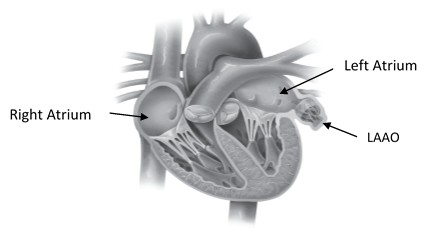Understanding your heart
The
heart is divided into 4 parts called chambers. The 2 upper chambers of the heart are the right and left atria and the 2 bottoms chambers are the right and left ventricles.
The 4 chambers fill with blood when the heart is at rest and then pump blood through the body when the heart muscle contracts (shortens) with each heartbeat. The electrical system of the heart causes the heart muscle to contract and pump blood through the blood vessels.
After the heart pumps the blood, it rests and fills with new blood until the next contraction of the heart muscle.
What is atrial fibrillation and how is it treated?
In
atrial fibrillation (AF), the right and left atria don’t contract at the same time as the ventricles so the heart beat (pulse) is abnormal (irregular).
AF is treated with medicine to prevent the heart beat from getting too fast. The medicine usually helps people feel better so they’re able to do everyday activities, even when they have AF.
Not everyone who takes medicine for AF, will feel better. If this happens, you will need more of the same medicine, another type of medicine, or a heart procedure such as cardioversion and ablation to try to stop AF and keep the heartbeat regular.
Cardioversion uses electricity or chemicals to make the heart beat normal.
Cardiac ablation uses heat or freezing to destroy the part of the heart that is causing AF.
Left atrial appendage occlusion (LAAO) is a procedure that prevents blood clots in the left atrial appendage related to AF from going into the blood stream and causing a stroke. It is used along with medicines or other procedures to treat AF.
Heart showing the left atrium and appendage
 Source: Boston Scientific, 2015, Watchman Patient Guide
Source: Boston Scientific, 2015, Watchman Patient Guide
Atrial fibrillation and blood clots in the heart
The blood flow in the atria may be slower than normal when you have atrial fibrillation (AF). This can cause a blood clot (thromboembolus) to form.
A blood clot is a called a
thrombus when it stays in one place. If it breaks loose and travels to another part of the body, it’s called a
thromboembolus. A thromboembolus can be dangerous if it blocks a blood vessel that supplies blood to an important body part.
Blood clots related to AF that start in the heart most often develop in a pouch of the left atrium called the left atrial appendage (LAA).
If a blood clot leaves the LAA, it can travel to different parts of the body and get stuck in a blood vessel. This can block the flow of blood to organs and damage them. If a blood clot blocks a blood vessel in the brain, it can cause a stroke. The part of the brain that’s supplied by that blood vessel can become permanently damaged within minutes.
A
stroke can cause loss of movement or feeling (sensation) in a part of the body, weakness, problems speaking, and even death.
How a blood clot gets to the brain

Source: Boston Scientific, 2015, Watchman Patient Guide
Not everyone with AF has the same risk for an LAA blood clot or stroke. You have a higher risk of an LAA blood clot or stroke if you:
- are over the age of 65
- have high blood pressure, heart failure, diabetes, or other heart disease
- have had a stroke (including a mini-stroke called a transient ischemic attack or
TIA) or blood clot in the past
Atrial fibrillation and blood thinners
People with atrial fibrillation (AF) have a higher risk of
stroke so they’re treated with medicines called blood thinners or anticoagulants that help prevent a stroke.
Most people can safely take a blood thinner for many years without any problems. But some people develop bleeding problems.
If this happens, bleeding problems are usually mild. But in some people, the bleeding can be bad enough that they have to be admitted to hospital and may even need a blood transfusion. In rare cases, bleeding can be life-threatening or cause death (from
bleeding into the brain or stroke).
Blood thinners prevent strokes more often than they cause them. Your doctor will decide if a blood thinner is the best treatment for you.
What if a blood thinner isn’t the best treatment for me?
For some people, the risk of serious bleeding is too high, so taking blood thinners isn’t the best treatment.
For these people, a left atrial appendage occlusion (LAAO) may be the best treatment.
If you’re doing well on your blood thinner treatment, and there’s no reason to think that you won’t keep doing well, LAAO is likely not the best treatment for you.
